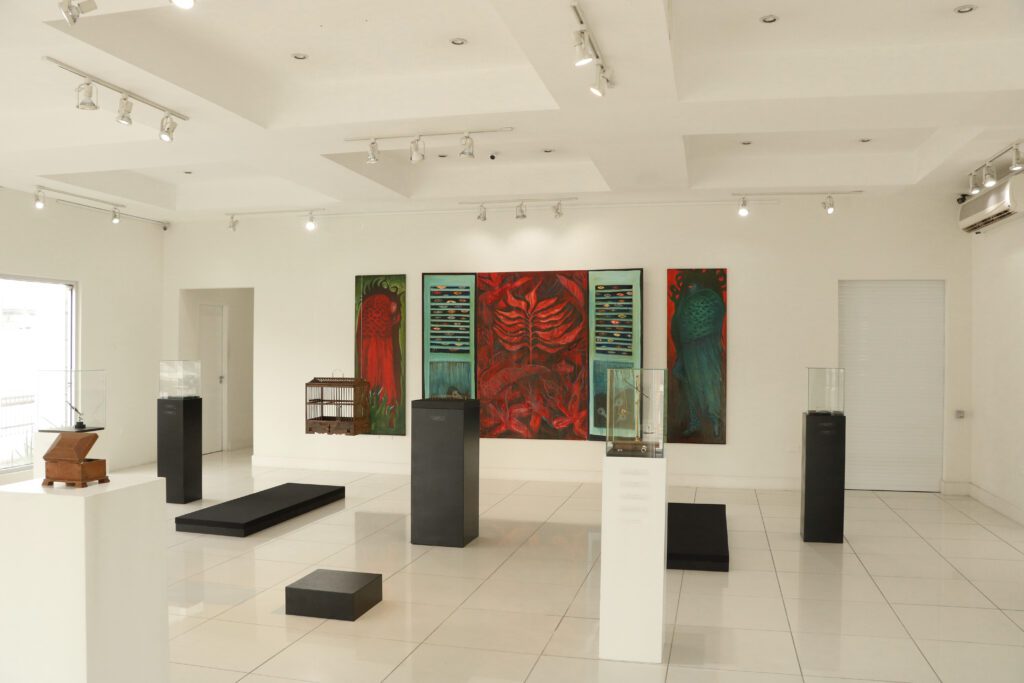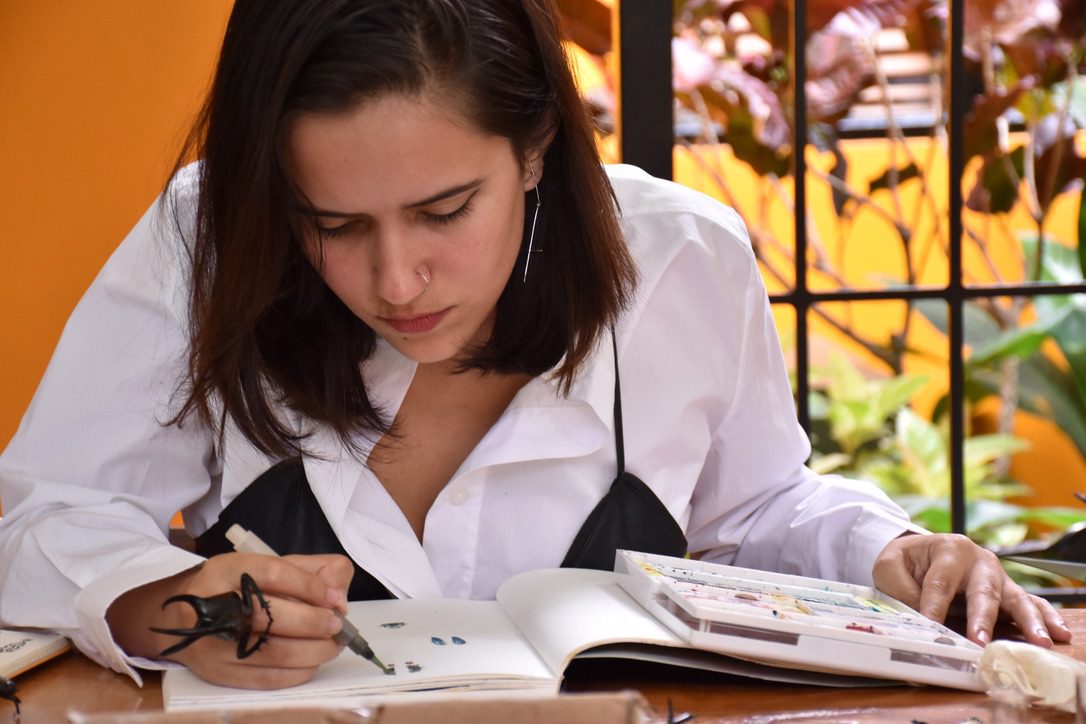
Altered I
2023
Ring
Sterling silver, gold vermeil, porcupine quills, garnet set over beetle elytra
Janice Derrick
2017
Sterling silver planished brooch with gold plate and small fine silver planished bowl
Janice Derrick
2017
Sterling silver planished brooch with gold plate and small fine silver planished bowl
FORM AND FEELING:
MAIRI MILLAR’S SIGNS OF LIFE
An Essay by Marsha Pearce
Around the time of the funeral for Queen Elizabeth II, artist Mairi Millar wrapped the corpse of a hummingbird in 14k gold. The metal covering traced its torso and wings like a delicate line drawing; the gold exoskeleton shimmering, and the creature’s metallic green and copper red feathers catching the light with equal measure. She then placed the body in a tiny box, its lid left just wide enough for us to steal a secret look. We were not meant to stare at the bird as if it were some spectacle but rather, in that sliver of visibility, discern a need for reverence, to pay our respects. “How will it make you feel,” asks Millar, “to know that someone has taken the time to make a death shroud for a hummingbird?” To feel is human. And yet, so many of us are numb. We may show signs of life: a breath, a heartbeat, but be dead inside – devoid of emotion.
In a global landscape of conflict, including the crisis in Sudan, the Israel-Hamas war, the Russian invasion of Ukraine and the territorial dispute between Venezuela and Guyana, we need vital signs – signs of compassion, fear, fury, sorrow and indeed, love – to counter what bell hooks calls a “wilderness of spirit so intense we may never find our way home again.” Can a jewellery exhibition help us find our way? “I am interested in not only how jewellery has a connection to our bodies, but also how it attaches itself to our humanity,” shares Mairi Millar, a graduate of the Jewellery and Metal Master’s programme at the Royal College of Art. Millar’s solo show Signs of Life, with its dialogue of sterling silver, found bird remains, 14K gold, human hair, crushed bones, eggshells and carrion flies, is an effort at reanimation, at reviving our consciousness. Through her play with form and materials, Millar reinscribes how we see jewellery and in doing so, she charts a way through a wasteland of being to bring her viewer to a site alive with feelings, a place built with the stuff of our human experiences – one in which we might dare to feel at home.
The arrangement of works at the gallery establishes a setting that both recalls the human body and invokes sentiment. Plinths carrying Millar’s jewellery pieces stand like headstones in a cemetery, each a cenotaph or empty tomb to commemorate the dead. At the back of the room, Millar amplifies ideas of death or departure by providing an exit point, a large painted opening leading to what seems to be a garden of bright, lush foliage. Upon a closer look at the painting, however, the doorway translates as an open chest cavity, where leaves become human viscera and the number of door louvres match that of a human ribcage. The image is an invitation to enter a body, to climb inside a life and have rapport with another. Millar manipulates notions of interior and exterior space, oscillating between exits and entrances, the living and the dead.
This slippage between life and death is an aesthetic feature of Caribbean human existence, one that poet Shivanee Ramlochan articulates vividly. Writing about jouvay, the daybreak performance ritual that launches the two-day carnival street procession in Trinidad, Ramlochan declares: “Play your dead eighty-year-old granny, who had tongue like scorpion pepper… Play all the dead and all the living in you, in yuh short pants, in yuh badjohn drawers… Wine en pointe and wine to the four stations of the cross, dutty angel… You eh waiting til next year. Where you plant yourself this Jouvay is where your spectral, midnight lagahoo rattling she coffin, turning wolf to woman to wolf again.”
What Ramlochan reveals with words, Millar suggests with oil on canvas, her painted portal moving us in and out, between this world and the realm of ghosts. And, just like a jouvay reveller who spreads arms wide to meet the sunrise, chest exposed to everyone and everything, Millar’s flung open doors offer a bare, vulnerable heart – a gesture that draws us into an intimate connection. It is against this backdrop of the heart that we are to interpret her jewellery designs. “Jewellery is a language,” says Millar. “It is not just about wearability. When we you see a crown you understand its subtext. Jewellery is a language of intimacy.” Millar understands that jewellery can speak to the deepest parts of us, unearthing strong feelings.
Her work titled “Purely Decorative,” is one example. Its name highlights Millar’s consideration of jewellery’s function. Contrary to convention, the work is anything but ornamental and prettifying. Millar presents a suspended birdcage within which a hummingbird is splayed like a crucifix. Its heart replaced with a garnet gemstone. What was bone is now gold. The open cage door echoes the idea of coexisting realms; the way death inside and life outside can bleed into each other. However, there is more to see, and yes, to feel here. “There is a sense of escape but the bird can’t. It is disfigured beyond flight,” Millar explains. “The open door is perhaps an invitation to reach in and violate the bird. This little cage is Trinidad for me. With this work, I feel like a woman in Trinidad, where someone can reach their hand and touch you if they want.”
For Millar, jewellery is “more than putting on a ring and going to a party.” It facilitates a “private moment for reflection.” What thoughts, then, might come to mind in response to her necklace of sterling silver flies? How might we feel? Titled “Once More With Feeling,” the piece is a garland of insects known for their attraction to dead flesh. And yet, the very presence of the flies points to life in the face of death. In a 2020 article, environmental scientist Paul Manning notes that “the process of turning a newly dead animal into a bony skeleton relies on an explosion of life that ushers in the process of decomposition. Much of this transformative process is performed by wriggling, scuttling, scurrying insects.” This perspective on life, coupled with the circular shape of the necklace (the circle as a symbol of resurrection and eternity) stir feelings of awakening and renewal, as much as they might evoke sensations of frightening change. Sharing her own reflection on this work, Millar observes: “It is the idea of escaping the grave, and if you were given a second chance at life, you should step into it with the deepest emotion. So like a directive for an orchestra or choir: once more, with feeling!”
Will we have more chances to live deeply? To live well? To safeguard those lives around us? In our contemporary context, where the death knell sounds for our humanity, Mairi Millar’s Signs of Life exhibition is an autopsy performed with great care. She uses her art to make an incision across our shoulders and down the middle, splitting us open. Her works succeed in dissecting us so that we examine our hearts. She urges us to laugh and cry and hurt and heal, joining our bodies and senses to feathers, porcupine quills, carpenter bee wings and iguana skin. Millar asks: what happens when jewellery designers use materials that have a similar expiry date to us? An answer is, of course, that we feel with and through these materials – not taking life for granted – until human and object are no more.
Marsha Pearce, PhD, is a lecturer in Visual Arts at the University of the West Indies, St. Augustine Campus. Her research and writings on the subject of visual culture have been published in several academic books, journals, and art catalogues.
Mairi Millar is a Trinidadian artist based in London. Her work explores the beauty of nature’s discarded and “collaborating with chance”, creating works from found natural objects. Primarily through the language of jewellery, these forgotten or “finished” objects are elevated to the state of a relic. An eggshell is proof something emerged, a feather means something flew. These found objects are charged with an intimate vibrancy compared to the seemingly valuable materials they are set in. Her practice is an ode to the finder’s treasure; from human hair to houseflies; she does not shy away from the macabre to find beauty and hope.
Mairi is an alum of the Rhode Island School of Design (2018) and the Royal College of Art (2021). In 2021 she was awarded a residency at The Sarabande Foundation in London established by Lee Alexander McQueen.

